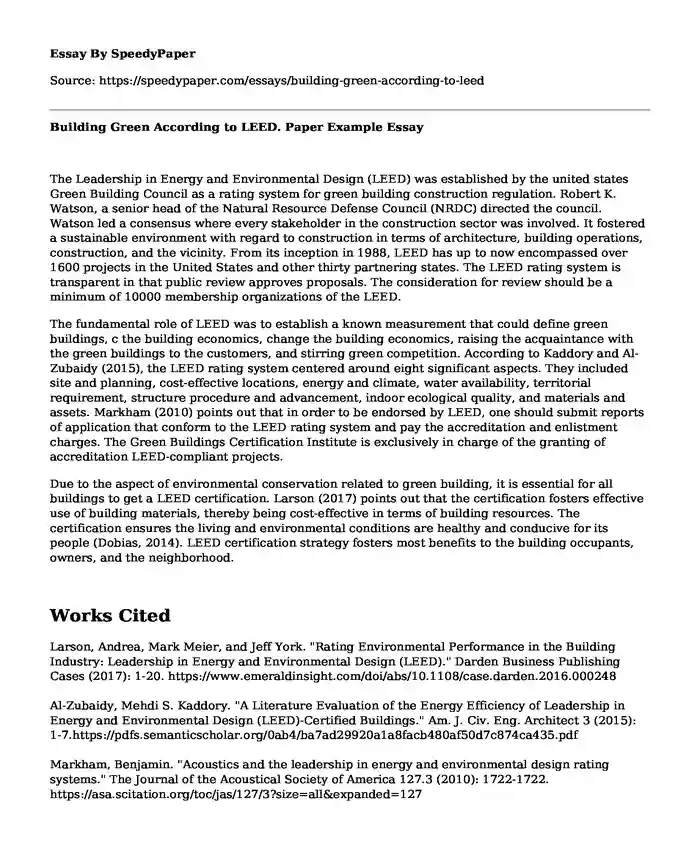
| Type of paper: | Essay |
| Categories: | Ecology Architecture |
| Pages: | 2 |
| Wordcount: | 504 words |
The Leadership in Energy and Environmental Design (LEED) was established by the united states Green Building Council as a rating system for green building construction regulation. Robert K. Watson, a senior head of the Natural Resource Defense Council (NRDC) directed the council. Watson led a consensus where every stakeholder in the construction sector was involved. It fostered a sustainable environment with regard to construction in terms of architecture, building operations, construction, and the vicinity. From its inception in 1988, LEED has up to now encompassed over 1600 projects in the United States and other thirty partnering states. The LEED rating system is transparent in that public review approves proposals. The consideration for review should be a minimum of 10000 membership organizations of the LEED.
The fundamental role of LEED was to establish a known measurement that could define green buildings, c the building economics, change the building economics, raising the acquaintance with the green buildings to the customers, and stirring green competition. According to Kaddory and Al-Zubaidy (2015), the LEED rating system centered around eight significant aspects. They included site and planning, cost-effective locations, energy and climate, water availability, territorial requirement, structure procedure and advancement, indoor ecological quality, and materials and assets. Markham (2010) points out that in order to be endorsed by LEED, one should submit reports of application that conform to the LEED rating system and pay the accreditation and enlistment charges. The Green Buildings Certification Institute is exclusively in charge of the granting of accreditation LEED-compliant projects.
Due to the aspect of environmental conservation related to green building, it is essential for all buildings to get a LEED certification. Larson (2017) points out that the certification fosters effective use of building materials, thereby being cost-effective in terms of building resources. The certification ensures the living and environmental conditions are healthy and conducive for its people (Dobias, 2014). LEED certification strategy fosters most benefits to the building occupants, owners, and the neighborhood.
Works Cited
Larson, Andrea, Mark Meier, and Jeff York. "Rating Environmental Performance in the Building Industry: Leadership in Energy and Environmental Design (LEED)." Darden Business Publishing Cases (2017): 1-20. https://www.emeraldinsight.com/doi/abs/10.1108/case.darden.2016.000248
Al-Zubaidy, Mehdi S. Kaddory. "A Literature Evaluation of the Energy Efficiency of Leadership in Energy and Environmental Design (LEED)-Certified Buildings." Am. J. Civ. Eng. Architect 3 (2015): 1-7.https://pdfs.semanticscholar.org/0ab4/ba7ad29920a1a8facb480af50d7c874ca435.pdf
Markham, Benjamin. "Acoustics and the leadership in energy and environmental design rating systems." The Journal of the Acoustical Society of America 127.3 (2010): 1722-1722. https://asa.scitation.org/toc/jas/127/3?size=all&expanded=127
Rockstroh, Kurt, et al. "Acoustics and the Leadership in Energy and Environmental Design (LEED) certification-Why education and healthcare came first." The Journal of the Acoustical Society of America 127.3 (2010): 1722-1722.
Dobias, Jiri, and Daniel Macek. "Leadership in Energy and Environmental Design (LEED) and its impact on building operational expenditures." Procedia Engineering 85 (2014): 132-139.
Ugur, Latif Onur, and Nese Leblebici. "An examination of the LEED green building certification system in terms of construction costs." Renewable and Sustainable Energy Reviews 81 (2018): 1476-1483.
Cite this page
Building Green According to LEED. Paper Example. (2023, Jan 15). Retrieved from https://speedypaper.net/essays/building-green-according-to-leed
Request Removal
If you are the original author of this essay and no longer wish to have it published on the SpeedyPaper website, please click below to request its removal:
- Fighting Addiction - Social Work Essay Sample
- Victim Involvement and Restorative Justice
- Paper Example: Formal Analysis of Court of San Martino, Venice
- History of Puerto Rico, Free Essay for Everyone
- Creative Works of Christi Belcourt. Essay Sample
- Free Essay - Role of Educational Leaders in the Future Schools
- Paper Example. Environmental Public Health Policy
Popular categories




